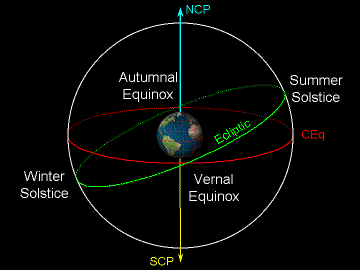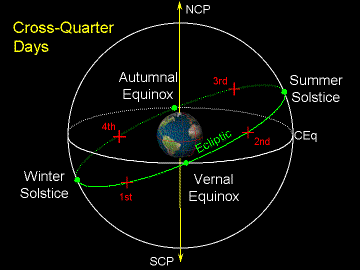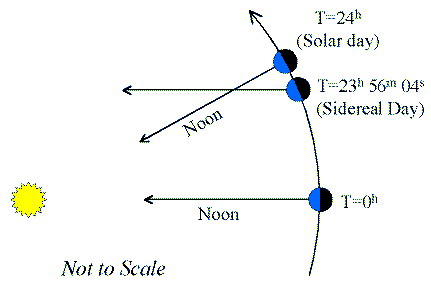Lecture 10: Telling Time
Key Ideas
Timekeeping is tied to Astronomy
Divisions of the Year:
- Quarter & Cross-Quarter days
- Months & Weeks
Divisions of the Day:
- Hours, Minutes & Seconds
- Solar & Sidereal Time
Civil Timekeeping & Time Zones
Keeping track of Time
All of our time-keeping conventions are astronomically based:
- The Year is based on the time it takes Earth to orbit the Sun.
- The Month is based on the cycle of the Lunar Phases
("Month" comes from "Moon").
- The Day is based on the time it takes the Earth to rotate
once on its axis relative to the Sun.
Dividing the Year
Solstics & Equinoxes
The first major division of the Year is into seasons marked by the
occurance of the Solstices and Equinoxes

- [Click on image for a larger view]
In many cultures, the Equinoxes and Solstices were marked by holidays,
some of which we still keep (in altered form) to this day
Solstice & Equinox Holidays
- Winter Solstice: Christmas, Yuletide, Saturnalia
- Vernal Equinox: Easter, Passover, Eoestre (Saxon)
- Summer Solstice: Midsummer (viz. A Midsummer
Night's Dream), St. John's Eve
- Autumnal Equinox: Mabon (Celtic/Welsh), Michaelmas (Feast of
St. Michael the Archangel)
Cross-Quarter Days
These occur at the mid-way points between the Solstices and Equinoxes
(they are sometimes called the "Mid-Quarter Days").

- [Click on image for a larger view]
These days are associated with many familiar holidays whose astronomical
roots have been largely forgotten.
Cross-Quarter Holidays:
- First Cross-Quarter Day (Feb 4): Imbolc (Celtic: "in milk"),
St. Brigit's Day, Candelmas, Groundhog Day,
Setsubun
(Japan)
- Second Cross-Quarter Day (May 5): Beltane (Celtic: "fire of
Bel", coming of summer), May Day, Walpurgisnacht, Feast of the
Conception of Mary
- Third Cross-Quarter Day (Aug 7): Lughnasa (Celtic: "games
of Lugh"), Lammas (loaf mass), Lughnasadh (Celtic: "games of Lugh"),
Feasts of St. Oswald and St. Justus of Lyon.
- Fourth Cross-Quarter Day (Nov 7): Samhain (Celtic: "summer's
end"), Halloween, Feast of All Saints, Feast of All Souls.
(Note: Halloween preceeds All Saints in the
same way Walpurgis Night preceeds May Day in the Spring).
Extra Notes on Cross Quarter Days
Months & Weeks
The year is also divided into 12 months.
- Why 12? There are 12.4 lunar synodic periods (cycles of phases)
during a year.
- The word for Month derives from the word for the Moon.
Months are divided into Weeks:
- The week is traditionally divided into 7 days
- Seven for the 7 moving bodies ("planets")
visible to the naked eye (Sun, Moon, Mercury, Venus,
Mars, Jupiter, and Saturn)
Names for Days of the Week
| Roman |
Anglo-Saxon |
English |
Spanish |
| Solis | Sun | Sunday | Domingo |
| Lunae | Moon | Monday | Lunes |
| Martis | Tiw | Tuesday | Martes |
| Mercurii | Woden | Wednesday | Miercoles |
| Jovis | Thor | Thursday | Jueves |
| Veneris | Freya | Friday | Viernes |
| Saturni | Saturn | Saturday | Sabado |
Dividing the Day
We divide the Day into 24 hours, with each day beginning at
midnight.
This wasn't always the case:
- The day usually began at dawn (sunrise).
- Equal division of Day and Night into 12 hours.
- The length of the hour was different for day and night
(except at the Equinoxes).
This division worked fine for sundials.
Equal Hours
The invention of mechanical clocks in the 1300s led to a need
for equal hours:
- Ensured the clocks read true in the morning.
- Simplified clock design.
Medieval clocks were large and complex:
- Erected in towers in cities for everyone to see.
- Led to a standardization of time keeping:
- Personal timepieces became common centuries later.
Dividing the Hour
Until 1500s, clocks only kept time to the quarter hour.
Further division of the hours was needed as clocks became more complex.
- 1 hour was divided into 60 minutes.
- 1 minute was divided into 60 seconds.
Seconds didn't become common until the 1670s after the invention
of the pendulum escapement: 39-inch pendulum clocks have a 1 second
period to their swing.
Solar Time
The Day is measured using the Sun.
- Local Solar Noon
- Occurs when the Sun is on your meridian.
- Mean Solar Day
- The time between successive Noons.
When noon occurs depends on your longitude:
- Person 15° east of you sees noon 1 hour earlier.
- Person 15° west of you sees noon 1 hour later.
Sidereal Time
Sidereal Time is measured relative to the stars.
As the Earth rotates through 1 day, it moves a little less than 1°
along its orbit around the Sun.

(Click on the image to view at full scale [Size: 9Kb])
- As seen with respect to the stars, the Earth has move for
an extra 4 minutes in order for the Sun to return to the
observer's meridian (noon).
- Stars rise 4m earlier each night measured
against solar (civil) clocks.
Standard Time
The invention of rapid long-distance railroads and telegraph
networks required a new way of standardized time keeping:
- Coordination of interstate railroad schedules.
- Telegraph lines linked many widely separated longitudes
instantaneously, but needed to coordinate them.
Small differences in local solar time began to matter.
Time Zones
The idea of "Standard Time" arose in the 19th century, coinciding
with the rise of railroads which connected great distances more quickly.
Various local system arose in Britain, US, and Canada, with the
international system of time zones being adopted in 1884.
- Divided the Earth into Time Zones by longitude from the
Prime Meridian.
- Basic time zones are 15° of longitude apart (360°/24h
= 15°/hour)
- Each time zone keeps local solar time for a fixed
reference longitude.
- All longitudes within that zone use "Zone Time"
instead of local solar time.
The creation of standard time was the work of many individuals,
including William Wollaston (who developed the idea of a common time for
all British railroads in the 1840s), Charles Dowd (who devised a
multi-latitude system of time zones for US railroads in the 1870s), and
Sir Sandford Fleming of Canada who devised the worldwide system we use
today.
Added complications:
Actual timezone borders do not follow the meridians.
- Cities, counties, and small countries want to be on the same time system
for ease of governance.
- Some states refuse to have multiple time zones.
- Keep some island nations from being divided.
This results in irregular time zone boundaries that cannot be easily
computed a priori. One usually has to resort to consulting a map.
Want to Know More?
In my opinion, the single best site on time and timesystems on the
internet is the Time Service
Department of the U.S. Naval
Observatory. The Navy Dept. is the official timekeeper for the
United States, and their website has a huge amount of information on
timekeeping, clocks, time systems, sunrise/sunset/moon phase, times of
solstices and equinoxes, and much more.
This particular lecture attracts a great deal of attention from outside
my students, and I wish to thank everyone over the years who has sent
comments, questions, and suggestions for improving the information on it.
Return to [
Unit 2 Index
|
Astronomy 161 Main Page
]
Updated: 2007 September 29
Copyright © Richard W. Pogge, All Rights
Reserved.


